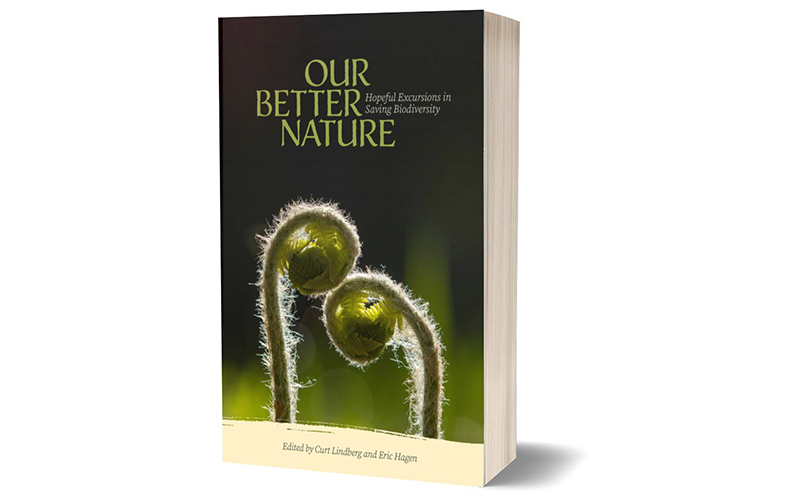Biologist E.O. Wilson once said, “We should preserve every scrap of biodiversity as priceless, while we learn to use it and come to understand what it means to humanity.”
The Vermont Alliance for Half-Earth, Vermont Natural Resources Council, Northeast Wilderness Trust, and the Lintilhac Foundation, inspired by Dr. Wilson’s lifelong work, have released, with the help of a handful of Valley residents, “Our Better Nature: Hopeful Excursions in Saving Biodiversity,” a book dedicated to the idea that to protect the human species and right to live on this planet, humans must also protect the rights of the nine million other species on the planet.
The origins of the book go back to Half-Earth Day 2018, when a group of Vermont-based conservation-minded residents, including Valley residents George Schenk, Claire Lindberg, and Curt Lindberg, traveled to the American Museum of Natural History in New York City to hear Dr. Wilson speak about the Half-Earth Project that he inspired. The group returned to Vermont, energized to bring Dr. Wilson’s compelling Half-Earth message to Vermont and founded what has become known as the Vermont Alliance for Half-Earth.
“A single quote from Dr. Wilson resonated deeply with us,” recalled Schenk. “There can be no purpose more inspiring than to begin the age of restoration, reweaving the wondrous diversity of life that still surrounds us.”
Cooperatively written by members and friends of the Vermont Alliance, “Our Better Nature” is an illustrated book of essays that celebrates the beauty of Vermont, the commitment to protect its biodiversity, and the steps being taken to ensure that the effort to do so is eternal.
“But the lessons go far beyond the borders of Vermont: The book’s teachings cover a broad array of topics, ranging from land management to conservation to environmental stewardship to the sheer joy of just being out there,” said Lindberg, who co-edited the book. Schenk penned the foreword.
“The Vermont Natural Resources Council is pleased to be one of the publishers of “Our Better Nature,” a work filled with stories about what Vermonters are doing now to protect biodiversity, practical tips on what people can do on the land to provide needed habitat for Vermont’s many species, and essays by regional experts who help us understand the power of resilient ecosystems, of nature education for all ages, and Vermont’s dedication to conservation science. We’re delighted that the work is being so well-received by some of the state’s leading conservations voices,” said Brian Shupe, executive director of the Vermont Natural Resources Council and a member of the Waitsfield Select Board.
Here is what some reviewers had to say about the book.
“This book could not be more timely, more charming, more useful, or more needed! Anyone who cares about our small and lovely state will want to spend time with it – its impact will spread beyond Vermont’s borders.”
--Bill McKibben, author “Wandering Home,” founder 350.org.
“What a rare and lovely treat, to get to read such interesting and thoughtful essays written about nature, by people who have dedicated their lives to living close to and understanding the land of green hills and silver waters of Vermont. Through the eyes of these great writers and thinkers (and doers!), we get a bird’s-eye view of the beautiful and complex quilt of life in the Green Mountain state. Providing lessons that apply far beyond Vermont’s borders, these writers give us both a clear warning that this quilt is unraveling and invite us to join in celebrating, and saving, our natural world.”
—David K. Mears, executive director, Audubon Vermont.
“At a time when many key habitats and species are declining in Vermont and throughout the world, ‘Our Better Nature’ serves as a well-crafted and timely reminder of the critical importance of redoubling efforts to enhance working and wild landscapes. A must read for anyone interested in learning more about the nature of Vermont and many of the efforts to protect it for future generations.”
—Anthony D’Amato, professor, director of forestry program, University of Vermont.
The book is available locally at Tempest Book Shop, Waitsfield, and Bear Pond Books, Montpelier, and soon on Amazon.












